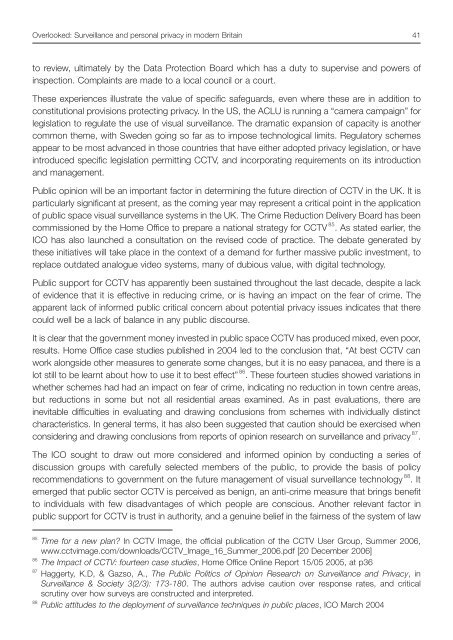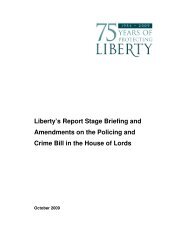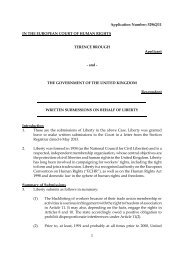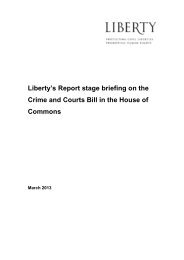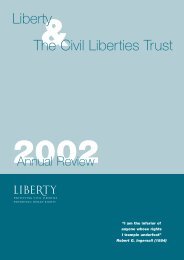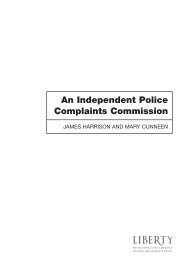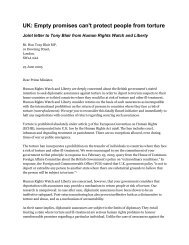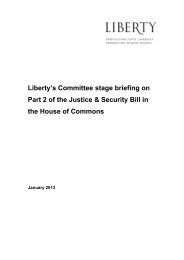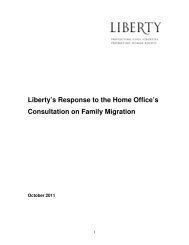Overlooked - Liberty
Overlooked - Liberty
Overlooked - Liberty
Create successful ePaper yourself
Turn your PDF publications into a flip-book with our unique Google optimized e-Paper software.
<strong>Overlooked</strong>: Surveillance and personal privacy in modern Britain 41<br />
to review, ultimately by the Data Protection Board which has a duty to supervise and powers of<br />
inspection. Complaints are made to a local council or a court.<br />
These experiences illustrate the value of specific safeguards, even where these are in addition to<br />
constitutional provisions protecting privacy. In the US, the ACLU is running a “camera campaign” for<br />
legislation to regulate the use of visual surveillance. The dramatic expansion of capacity is another<br />
common theme, with Sweden going so far as to impose technological limits. Regulatory schemes<br />
appear to be most advanced in those countries that have either adopted privacy legislation, or have<br />
introduced specific legislation permitting CCTV, and incorporating requirements on its introduction<br />
and management.<br />
Public opinion will be an important factor in determining the future direction of CCTV in the UK. It is<br />
particularly significant at present, as the coming year may represent a critical point in the application<br />
of public space visual surveillance systems in the UK. The Crime Reduction Delivery Board has been<br />
commissioned by the Home Office to prepare a national strategy for CCTV 85 . As stated earlier, the<br />
ICO has also launched a consultation on the revised code of practice. The debate generated by<br />
these initiatives will take place in the context of a demand for further massive public investment, to<br />
replace outdated analogue video systems, many of dubious value, with digital technology.<br />
Public support for CCTV has apparently been sustained throughout the last decade, despite a lack<br />
of evidence that it is effective in reducing crime, or is having an impact on the fear of crime. The<br />
apparent lack of informed public critical concern about potential privacy issues indicates that there<br />
could well be a lack of balance in any public discourse.<br />
It is clear that the government money invested in public space CCTV has produced mixed, even poor,<br />
results. Home Office case studies published in 2004 led to the conclusion that, “At best CCTV can<br />
work alongside other measures to generate some changes, but it is no easy panacea, and there is a<br />
lot still to be learnt about how to use it to best effect” 86 . These fourteen studies showed variations in<br />
whether schemes had had an impact on fear of crime, indicating no reduction in town centre areas,<br />
but reductions in some but not all residential areas examined. As in past evaluations, there are<br />
inevitable difficulties in evaluating and drawing conclusions from schemes with individually distinct<br />
characteristics. In general terms, it has also been suggested that caution should be exercised when<br />
considering and drawing conclusions from reports of opinion research on surveillance and privacy 87 .<br />
The ICO sought to draw out more considered and informed opinion by conducting a series of<br />
discussion groups with carefully selected members of the public, to provide the basis of policy<br />
recommendations to government on the future management of visual surveillance technology 88 . It<br />
emerged that public sector CCTV is perceived as benign, an anti-crime measure that brings benefit<br />
to individuals with few disadvantages of which people are conscious. Another relevant factor in<br />
public support for CCTV is trust in authority, and a genuine belief in the fairness of the system of law<br />
85<br />
Time for a new plan In CCTV Image, the official publication of the CCTV User Group, Summer 2006,<br />
www.cctvimage.com/downloads/CCTV_Image_16_Summer_2006.pdf [20 December 2006]<br />
86<br />
The Impact of CCTV: fourteen case studies, Home Office Online Report 15/05 2005, at p36<br />
87<br />
Haggerty, K.D, & Gazso, A., The Public Politics of Opinion Research on Surveillance and Privacy, in<br />
Surveillance & Society 3(2/3): 173-180. The authors advise caution over response rates, and critical<br />
scrutiny over how surveys are constructed and interpreted.<br />
88<br />
Public attitudes to the deployment of surveillance techniques in public places, ICO March 2004


